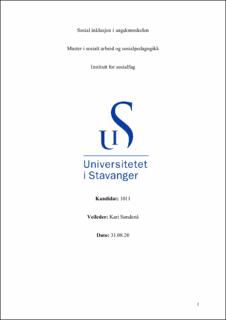| dc.contributor.advisor | Søndenå, Kari | |
| dc.contributor.author | Rosland, Erik | |
| dc.date.accessioned | 2021-01-24T17:02:28Z | |
| dc.date.available | 2021-01-24T17:02:28Z | |
| dc.date.issued | 2020 | |
| dc.identifier.uri | https://hdl.handle.net/11250/2724368 | |
| dc.description.abstract | Marginaliserte og sosialt ekskluderte elever kan være utfordrende å inkludere inn i et felleskap. Som miljøterapeut blir man utdannet til å være bevisst på denne problematikken, men allikevel kan det være vanskelig å håndtere. I min studie forsker jeg på skolesektoren knyttet til miljøterapeutens arbeid med sosial inklusjon. Formålet med studien dreier seg om å undersøke hvordan miljøterapeutene konkret arbeider med inkludering, samt belyse hvilke utfordringer som henger sammen med praktiseringen.
Til denne studien har jeg har gjennomført kvalitative intervjuer med miljøterapeuter fra fem ulike ungdomsskoler. Disse informantene ga meg noen interessante resultater rundt tidsaspektet, det relasjonelle aspektet, og ikke minst problematikk knyttet til å arbeide med inkludering som miljøterapeut.
Det skrives mange bøker om dette temaet, og derfor er målet å finne nye kilder til forståelse ved å diskutere informantenes perspektiver opp mot relevant teori og min egen empiri. Forhåpentligvis kan det bidra til at du får noen nye perspektiver på hvordan en miljøterapeut kan arbeide med sosial inklusjon i ungdomsskolen. | |
| dc.description.abstract | Marginalized and socially excluded students can be challenging to include in a community. As an environmental therapist, you are trained to be aware of this problem, but it can still be difficult to deal with. In my study, I research the school sector related to the environmental therapist's work with social inclusion. The purpose of the study is to investigate how environmental therapists specifically work with inclusion, as well as shed light on the challenges associated with the practice.
For this study, I have conducted qualitative interviews with environmental therapists from five different secondary schools. These informants gave me some interesting results about the time aspect, the relational aspect, and not least issues related to working with inclusion as an environmental therapist.
Many books are written on this topic, and therefore the goal is to find new sources of understanding by discussing the informants' perspectives on relevant theory and my own empirical data. Hopefully, it can help you get some new perspectives on how an environmental therapist can work with social inclusion in secondary school. | |
| dc.language | | |
| dc.publisher | uis | |
| dc.title | Sosial inklusjon i ungdomsskolen | |
| dc.type | Master thesis | |
